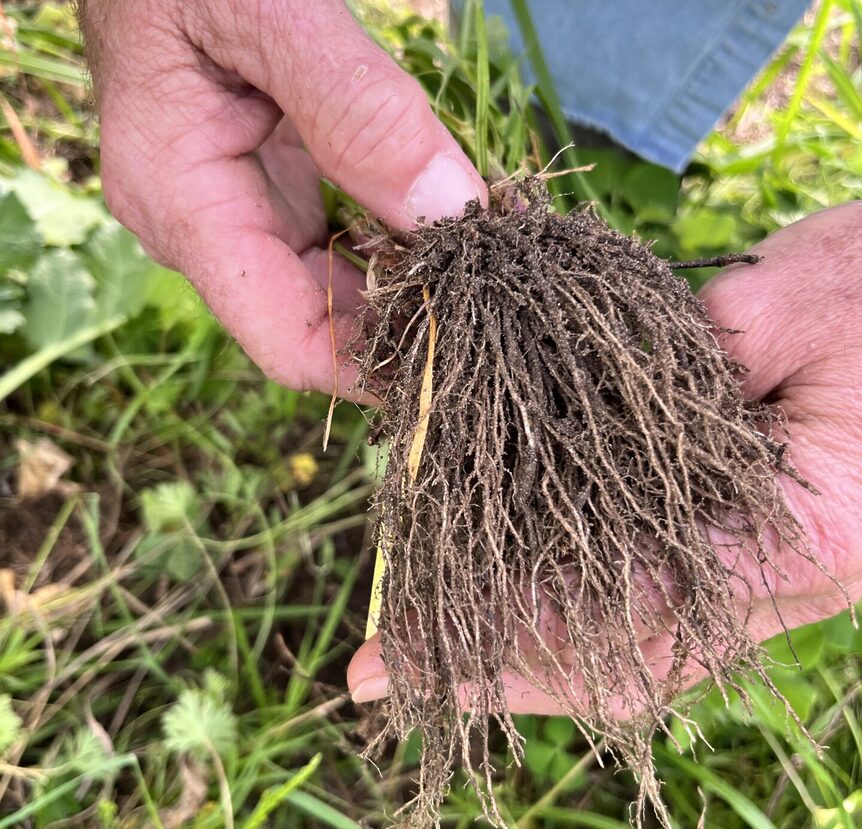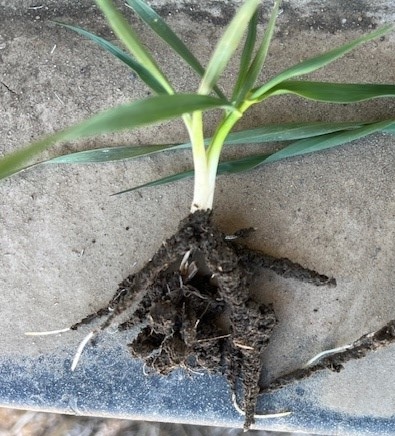Root exudates are an amazing feature of plant physiology, and a powerful tool to create a regenerative feedback loop of continually improving plant and soil health. When you boil it right down, much of what we do at AEA is trying to get plants to make more root exudates. In fact, if you were to define regenerative agriculture as succinctly as possible, you could do a lot worse than “optimizing exudates.”
But, like most invisible things, root exudates tend to get overlooked and ignored. Even some of the most brilliant practitioners of regenerative agriculture aren’t truly aware of the power of exudates.
So today, we are ending exudate ignorance! They are too important to regenerative systems to languish unnoticed and unloved.
What are exudates?
First things first, what exactly are these things? Root exudates are a cocktail of substances exuded by plants out of their roots. They’re largely sugars, but also contain amino acids, hormones, acids, signaling chemicals, and all sorts of other good stuff, as we shall see. Exudates are sometimes visible as a goopy substance on plant roots.
Below, we describe 7 superpowers of plant root exudates. This list is just a start; there’s a whole lot more to it. But it should help you appreciate their power in regenerating soils, and to encourage you to think about optimizing exudates as a key farm performance goal.
1. Feeding the Microbiome
High-functioning plants devote a ton of energy to root exudates—up to 70% of their photosynthesized carbon in extreme situations, but generally closer to 25%.
Question: Why would a plant just give away so much of its energy?
Answer: to feed the microbiome.
If you’re a capitalist deep down, you could call this a loan that the plant expects to be paid back with interest later in the growing season. If you have more of a communalist bent, you could call this a prime example of a highly-functioning gift economy.
Either way, giving so much away is well worth it to the plant: a well-fed microbiome will perform functions that a plant cannot: releasing bound-up nutrients in the soil, capturing atmospheric nitrogen, and lots more.
2. Building Stable Soil Carbon
Incorporating crop residue into the soil is a foundational practice for building soil carbon. But not all forms of carbon are created equal. While crop residue is nice, root exudates are nicer—5 times as nice, to be precise.
Studies have examined how stable various sources of carbon are in the soil. Dr. Christine Jones summarizes the results: “An analysis of 10 [experiments] found the stabilisation of root-derived carbon [averaged] 46%, while the stabilisation of carbon derived from above-ground biomass [averaged] 8.3%. Overall, the stabilisation of root-derived carbon was five times higher than that from above-ground biomass“
Meaning that if you’re looking to build long-term stable soil carbon, using root exudates as the source of that carbon are the way to go.
3. Creating a Disease-Suppressive Microbiome
Exudates contain more than just carbon—they also contain phytohormones and other signaling chemicals that communicate with the microbiome and beyond. All these components combine to help create the disease-suppressive microbiome that’s one of the ultimate goals of regenerative agriculture.
Here are a few of the things exudates have been proven to do, per Marschner’s Mineral Nutrition of Plants:
- directly suppress certain soil-borne root pathogens
- indirectly suppress pathogens by attracting those pathogens’ antagonists
- play a key role in plant defense mechanisms
- stimulate germination of parasitic plants
- induce spore germination and hyphal branching of arbuscular mycorrhiza fungi
Whoa!
4. Altering Soil Chemistry
Plants can alter the soil pH in the immediate vicinity of their roots using exudates—the rhizosphere can be up to 2 points pH higher or lower than the bulk soil. This means that not only can plants change the soil chemistry to better suit their own preferences, they can also inhibit or promote microbial growth. For example, plants exude carboxylates to mobilize phosphorus in the soil, and at the same time, those exudates acidify the soil to prevent microbial breakdown of those carboxylates, so they persist longer.
5. Taking Up Micronutrients
As we just mentioned, exudates can help plants mobilize phosphorus. But that’s not all. Iron-deficient grain plants have been shown to release phytosiderophores in their exudates, which mobilize not only iron, but also zinc, copper, and manganese. That’s all in addition to the nutrient mobilization fostered indirectly through a flourishing microbiome.
6. Retaining Water
Root tips secrete mucilage—a sticky gel that can bind with soil particles and microbes to form a substance called mucigel. Mucilage is also responsible for forming rhizosheaths around root hairs.
Mucilage can improve the water-holding capacity of soil, but also turns hydrophobic during drought, which decreases water loss from roots. A study has shown this reduced water loss to be about 30% in plant families adapted to arid conditions.
7. Exclusion of Toxins / Heavy Metals
Mucilage also helps exclude heavy metals like Aluminum, Cadmium, and Lead, by complexing them with galacturinates. A study of cowpeas exposed to aluminum toxicity showed 8 times more aluminum in the mucilage than root tissue. Aluminum content in the roots increased when the mucilage was removed.
How do you optimize exudates?
Hopefully this exudate exaltation has excited you.
So let’s get down to practicalities: how can you optimize exudates on your farm?
The first step is to enhance photosynthesis. When plants are photosynthesizing more efficiently, they generate a surplus of sugars, and increase the amount of exudates they provide to the soil. This feeds the microbiome, which releases more nutrients to feed to the plants, and generates a positive feedback loop of improving health.
Our Plant Health Pyramid is a great thing to refresh yourself on at this point: level 1 is all about optimizing photosynthesis.
Help us end exudate ignorance!
Share this with an exudate ignoramus in your life, and together we can regenerate the planet a little bit faster.
Further Reading:
Christine Jones. “Light Farming” https://amazingcarbon.com/JONES-LightFarmingFINAL(2018).pdf
Marschner’s Mineral Nutrition of Plants, 4th Edition. Rengel, Cakmak, and White: eds. Section 14.6: “Rhizodeposition and Root Exudates”
Citations:
Marschner, Horst et al. “Root-induced changes in the rhizosphere: Importance for the mineral nutrition of plants.” Journal of Plant Nutrition and Soil Science 149 (1986): 441-456.
Rasse, D.P., Rumpel C. and Dignac M-F. (2005). “Is soil carbon mostly root carbon? Mechanisms for a specific stabilisation.” Plant and Soil 269:341–56. DOI 10.1007/s11104-004-0907-y
Jackson, R.B., Lajtha, K., Crow, S.E., Hugelius, G., Kramer, M.G. and Pineiro, G. (2017). “The ecology of soil carbon: pools, vulnerabilities and biotic and abiotic controls.” Annual Review of Ecology, Evolution, and Systematics, 48:419–45. http://www.annualreviews.org/doi/pdf/10.1146/annurevecolsys-112414-054234
Subscribe to our blog to get each post to your inbox.
You'll get each post to your inbox (~1x/week).
You may unsubscribe at any time. We value your personal information. Here's our Privacy Policy.
"*" indicates required fields



